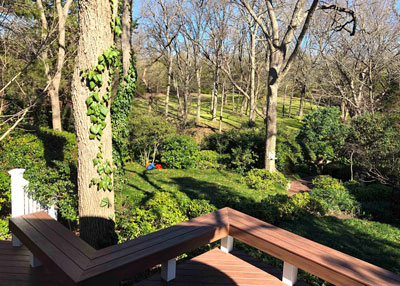Finally, the Backyard
When we built our house in the country (now quickly becoming citified!), we were surrounded by eastern redcedar junipers. I’ve had design help twice at the Sperry home landscape.

This is what we see for five months every winter as we sit down to dine or visit in our sunroom. I guess I can admit that it’s why our house was built where it is. It’s changed a lot over the past 42 years. Click image for larger view.
The first time I reached out for assistance was for the driveway, as I mentioned earlier here, and the other was for the configuration of our deck. (Shout out to Kim Andersen, then of Andersen’s Greenery.) Native redcedars (Juniperus virginiana) zigzagged their way up near our house creating a dramatic and beautiful enclosure just 10 feet out from our windows. We were almost living with nature as we looked directly into the woods.
But as the redcedars grew thin and lanky because of the shade of the pecans, it became obvious that we needed to take them down. That took away our intimacy with nature, and it took away our privacy with the neighborhood. There are families just beyond the ridge at the top of the hill.
I set out to clear the brush and the briars that had been obscured by the redcedars. Using the same outline of the original deck, we twice replaced it with new, fresh materials – most recently with a more permanent manmade surface from Future Outdoors of Midlothian so that carpenter bees could no longer be our enemies.
I laid 150 feet of walkway using 110-year-old street paving bricks from a North Texas city that sold them to me during a major utility upgrade. You can see a short part of that walk middle-right of my photo. Just above that walk and slightly to the right, obscured by the shadows with just two little tan tabs sticking out into the sunlight – you guessed it, two more of my chimney pots.
Among a few other species of shrubs, you’re also looking at more than 15 varieties of hollies. And that’s mondograss as the groundcover and what remains of a prior groundcover, Persian ivy that’s climbing the trunks. We keep it trimmed back to 15 or 16 feet every winter.
Across the creek you can see the rye that resulted from planting 100 pounds of seed in mid-October. We watered it one time and only one time. I offer that as evidence that having ryegrass doesn’t mean that you’ll waste water in winter. I hope cities that ban it will take that into consideration. If that grass hadn’t been there we would have lost massive amounts of topsoil to erosion during the fall rains.
And my final note from this photo. Across the creek and in the distance you see a blur of evergreen trees. Those are the redcedars that I planted 22 years ago to give us the much-needed privacy. I bought knee-high seedlings from a neighboring farmer who wanted to get rid of them. I paid him a dollar a tree – and he thought I was crazy. But by buying those small trees, I had privacy within about three years. I planted them somewhat along our property’s boundary, but I zigzagged them erratically on 18- to 22-foot spacings so they would look natural. We carried water to them weekly for their first two summers, and they’ve been on their own ever since. I’ve seen so many people try to buy large specimens only to have them turn brown and die. This species transplants easily while the trees are young, yet they’re very difficult once they’re 6 or 8 feet tall or taller. You can’t tell it from this distance, but these trees are now 20 to 25 feet tall and beautiful.
Note: The only thing missing in this photo is our bird feeders. That’s my goal for next week. We got three of them cleaned up and ready, and I’m planning my supply trip to Wild Birds Unlimited. I just need to get them hung. They’ll be fun for the grandkids and me the rest of the winter.
